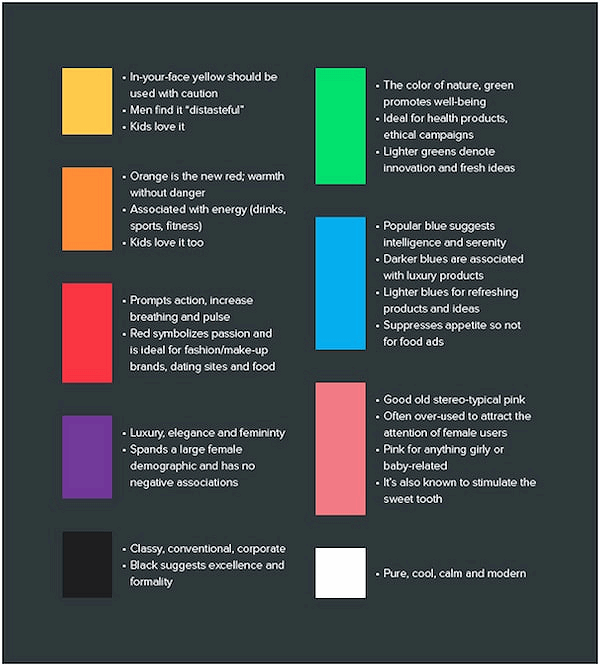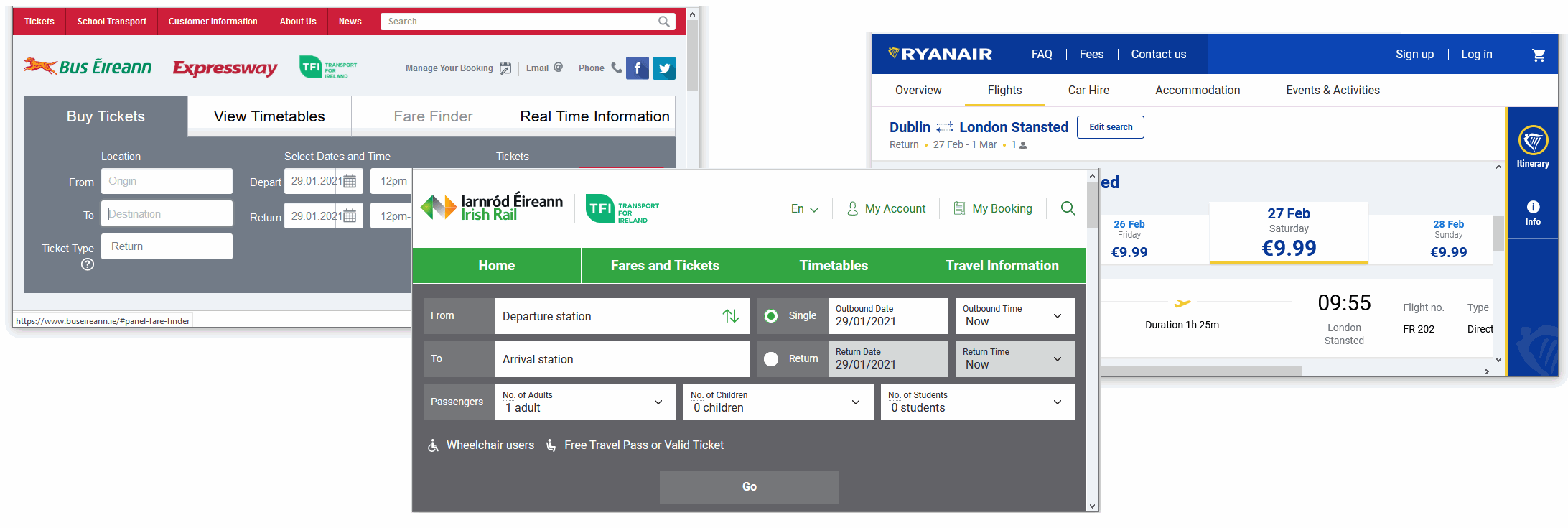Learning Goals
At the end of this Tutorial, you will be able to:
- Understand the three main colour systems used in web design: colour names, RGB values and hex codes.
About colours in web design
Colours provide web pages with interest and personality. You can see from the examples below how the same image but with different dominant colours affects the impact of a web page.

In deciding which colours to use with your web pages, you may find the list of resources at the end of this Tutorial helpful.
Below is a colour psychology infographic from one of the resources.

Keep in mind that the above chart will not hold true for every individual. However, this information is a good, research-based starting point for deciding your website colour choices.
Choosing your dominant ‘brand’ colour
Your website will have one main or dominant colour that will also be the main colour of your 'brand'.
For Bus Eireann, for example, the main brand colour is red. For Irish Rail, it is green. And for Ryanair, it is blue.

For choosing a modern-looking dominant colour for your website, check out the Flat Colours UI and Bootflat websites.
Creating your colour palette
In addition to your chosen dominant colour, you will typically select one, two or three other colours to create a colour combination or palette of colours that work together harmoniously.
Two good websites for helping you decide on a colour palette are Colour Hunt and Muzli Colours.

Colours: two common CSS properties
The two most commonly used CSS colour-related properties are listed below. Note the US-style spelling in each case.
- color: You use this to set the colour of text elements, such as headings, paragraphs, lists and hyperlinks. By default, web browsers display all text in black.
- background-color: You can use this to set the colour behind selected HTML elements or the background of the entire <body> of a web page. All backgrounds are coloured white by default.
color: /* Insert colour value here */;
background-color: /* Insert colour value here */;
In the example below, you can see the text elements <h2> and <p> both have a color of dark blue. They are positioned against a background-color of light pink.

body { background-color: #fef1ef }
h2, p { color: #1e266d }
By default, each web page has a white-coloured background. You could change this another light colour by entering the following at the end of global.css.
body { background-color: #f7f7f7 }
Aim for a harmonious combination of text and background colours in the main content area of your web pages.
In web design, there are three common systems for setting colours:
- The colour name system
- The RGB system
- The hex code system
The next three sections of this Tutorial will explain each colour system in detail.
The colour name system
Simply typing a colour name – such ‘red’ or ‘blue’ (without quotes) – in a CSS style rule is a common starting point when designing a new web page.
h1 { color: red }
Many colour names are both easy-to-remember and self-explanatory. For example, ‘yellow’, ‘purple’ and so on. Other colour names are less obvious, such as ‘hotpink’, ‘mediumvioletred’ and ‘lavenderblush’.
Colour names are not case-sensitive. For example, these three versions of the same colour name are all valid.
h3 { color: DarkOrchid }
h3 { color: darkorchid }
h3 { color: DARKORCHID }
You can see a full list of colour names on this W3 Schools web page.
However, the final version of a web page will typically use either RGB values or hex codes rather colour names for the following two reasons:
- Limited choice: Modern electronic screens can display at least 16 million different colours. With colour names, you are limited to only 147 choices.
- Misleading names: Even when colour names are easy-to-remember, they are not always accurate. For example, DarkGray is actually lighter than Gray.

Note that, in CSS, the colour name of grey can be written in either US spelling (gray) or UK spelling (grey). Either will work correctly.
The RGB colour system
The RGB system is based on the following idea:
Any colour can be created by combining different intensities of the three primary colours: red, green and blue.
Here are a few points about the Red-Green-Blue colour system:
- Every RGB colour is written as a list of three values: first the red value, then the green value, and then the value for blue. The individual values are separated from one another by commas.
- You can write each individual value as a number in the range 0 to 255. The following RGB code will produce the colour red: 255,0,0
- The three values are enclosed within brackets and preceded by the letters rgb (in lower-case or upper-case). In the example of red, the CSS value would look as follows: rgb(255,0,0)
The following examples of CSS style rules show the RGB system used to create the three colours of blue, a light brown and magenta.
h1 { color: rgb(0,0,255) /* blue */ }
h2 { color: rgb(255,248,220) /* light brown */ }
h3 { color: rgb(255,0,255) /* magenta */ }
The hex code colour system
This is the colour system most widely used in web design. As with the RGB system, the displayed colour is created by combining different intensities of red, green and blue. But the hex (short for hexadecimal) code system is different in four ways:
- The hex colour code begins with the hash (#) symbol.
- No commas are used to separate the red, green and blue values from one another.
- The list of red, green and blue values is not enclosed in brackets.
- The red, green and blue values are each written as a pair of two hexadecimal numbers.
Here are the three colours of blue, light brown and magenta written as hex codes in CSS style rules.
h1 { color: #0000FF /* blue */ }
h2 { color: #FFF5DC /* light brown */ }
h3 { color: #FF00FF /* magenta */ }
Like colour names, hex codes are not case-sensitive. For example, both #0000ff and #0000FF are valid and display the colour blue.
Three-character, short-hand hex codes
Not every hex colour code needs to be written as a string of six digits. You write some hex colours in three-digit shorthand.
Consider the example of the colour white. In CSS, you can write this in two ways:
#ffffff
-or-
#fff
The general rule is as follows:
If any one of the three pairs in a six-digit hex code is a duplicate, you need only write that hex digit once.
You can see some more examples of three-digit hex codes below.

For every colour above, three pairs of duplicate hex digits (such as 00, 33 or FF) are shortened into one digit.
Colour contrast and accessibility
Some colour combinations that are easy for most people to read are difficult or impossible for others. It is estimated that about 20% of web users have some form of limited vision.
In particular, about 1 in 12 men and 1 in 200 women have some form of 'colour blindness'. That means about 5% of your website visitors will not experience your site the way you intended.
There is little point in creating great text content for your website if a significant percentage of your website visitors struggle or cannot read what is on their screens.
An important factor is colour contrast – the difference between the foreground and background colours.
The WebAIM guidelines recommend a minimum contrast ratio of 4.5:1 for text on web pages. For headings and other large text, a contrast ratio of 3:1 is sufficient.
Notice the difference in the contrast ratios shown below. The image is from Google's web.dev website.

Further resources
Colour psychology 101: How colour affects perception of your website
By Safa Khudeira at the Intechnic Blog
How to use the psychology of colour to increase website conversions
By Neil Patel at the Neil Patel Blog
Understanding colour psychology for impactful web design
By Jerry Cao at DesignModo
The psychology of colour in web design
By Jenni McKinnon at the Envato Blog
Chapter 4: Color
From The Magic of CSS by Adam Schwartz
Color Hunt
A platform for colour inspiration with user-contributed colour combinations.
Muzli Colors
A colour palette/schemes generator.

